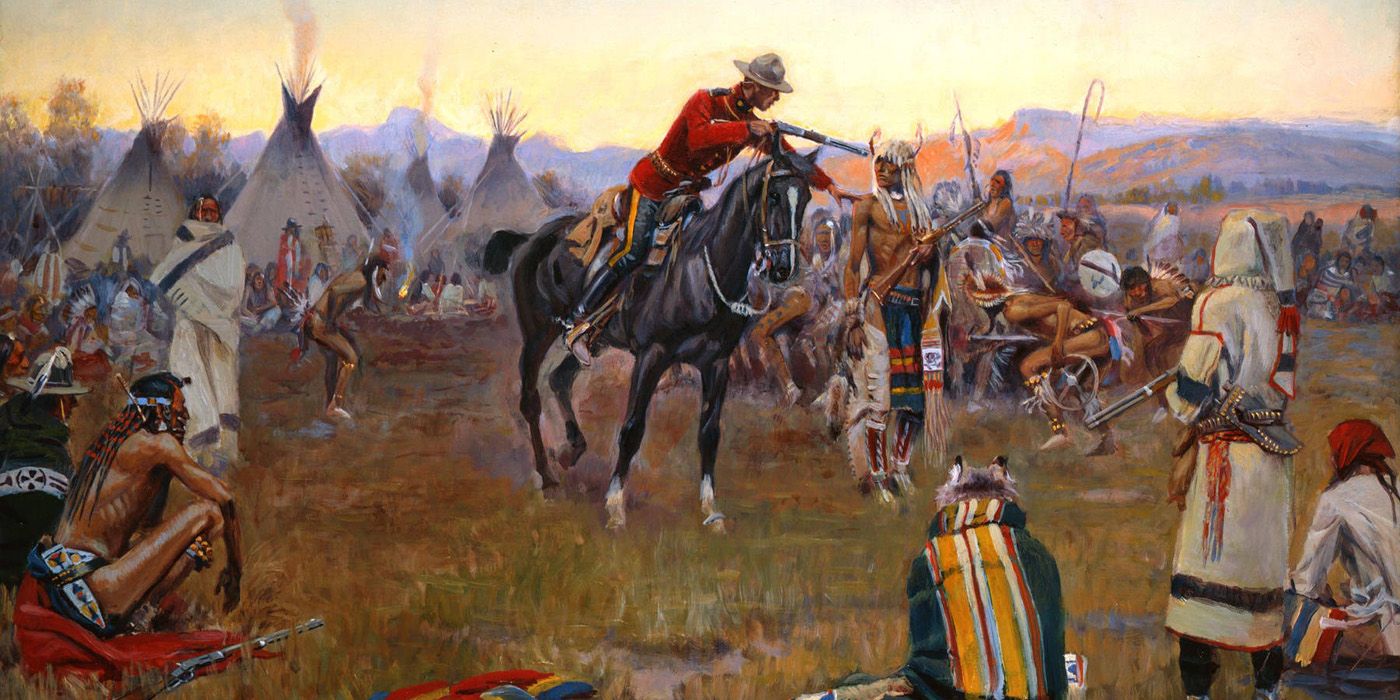
The Mountie is as recognizably Canadian as hockey, 'eh', or the maple leaf itself. When someone thinks of the Mountie, they inevitably picture the iconic and unmistakable red serge, stetson hat, and knee high polished Strathcona boots. An image made famous the world over largely by movies, Hollywood has long glamourized the stout Mountie as always saving the day - complete with chiseled good looks and, so often, a voice worthy of an appearance on Canadian Idol.
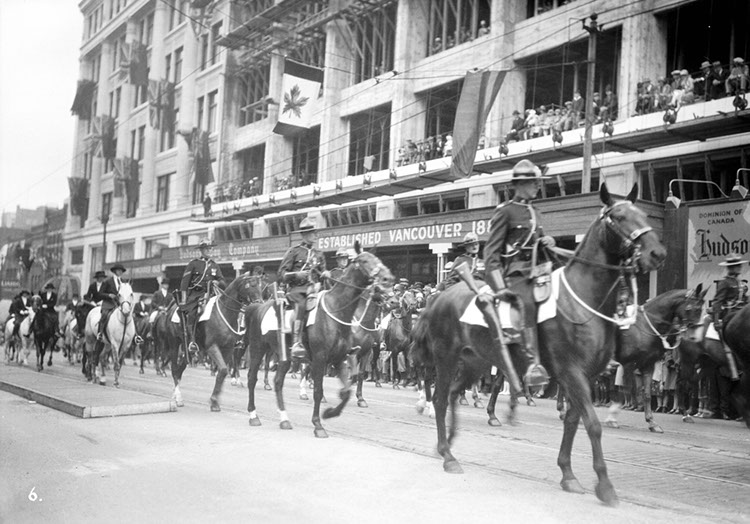 But beyond their fabled uniform, their mystique isn't entirely a product of a Hollywood screen play. The famed idiom that 'a Mountie always gets his man' was a hard earned reputation from the days of Canada's vast Western frontier in the newly acquired North West Territories. It was when the force was still known as the North West Mounted Police, seeing just a few hundred men initially make up the force which patrolled the vast wilderness and sparsely populated landscape, bringing the Queen's law and order to the frontier.
But beyond their fabled uniform, their mystique isn't entirely a product of a Hollywood screen play. The famed idiom that 'a Mountie always gets his man' was a hard earned reputation from the days of Canada's vast Western frontier in the newly acquired North West Territories. It was when the force was still known as the North West Mounted Police, seeing just a few hundred men initially make up the force which patrolled the vast wilderness and sparsely populated landscape, bringing the Queen's law and order to the frontier.
By the turn of the 20th century, concerns were apparent that the force was becoming increasingly antiquated, especially after the Great War. Canada's Western provinces were no longer the expansive and unruly wilds of the previous territories. With the railroad, it brought a modern, more urbanized populace with modern industries. The need for a frontier force was dwindling, teetering with dissolution until ultimately, in 1920, this was avoided with its merger with the Dominion Police and so was born the RCMP. Since then, the RCMP has been recognized the world over as a professional police force, carrying on the paramilitary traditions of the NWMP (later the Royal North West Mounted Police) and the irreplaceable red serge; a force unique the world over.
Quite often the law is, and was, enforced without firing a shot. While the Wild West will forever be remembered for its gun fighter ethic, the Mounties - though skilled with both shoulder and side arms, were not quick to draw. This remains true today. But the inherent dangers of such a job dictates the men and women who don the uniform carry the tools required to preserve life, maintain the peace, and protect property. The firearm is one of those tools. Join Calibre as we take a look at the historical arms of the NWMP.
Much of the reputation of the force in its early days were the product of silent courage, such as the almost unbelievable feat on morning of May 26th, 1877. The newly formed force dispatched a handful of men under command of Superintendent J M Walsh to a camp of several hundred potentially hostile Southern Assiniboine warriors to place several individuals under arrest for an unprovoked attack on a nearby band of Saulteaux. Not only were the parties responsible arrested, it was done so without firing a single shot.
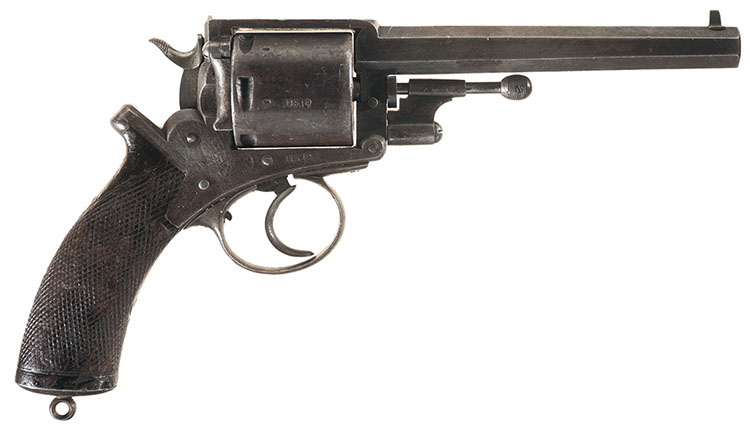
Used: 1873-1875
Procurement: 330 (of each Mk I & Mk III)
Cartridge: .450 Adams (Boxer)
Capacity: 5 round cylinder (Mk I) 6 round cy linder (Mk III)
The first side arm of the force was the Beaumont Adams revolver, which arrived from England via the British War Department in the summer of 1874 at Fort Dufferin, near present day Emerson, Manitoba. The Beaumont Adams was an evolution of the Dean and Adams percussion revolver of 1851, which was the first double action pistol to receive a patent. Being without a hammer spur and costly to manufacture, a veteran of the Crimean War, Lt. Frederick E B Beaumont, improved the design with body improvements and a hammer spur to allow for true single action – double action capabilities. It is widely said this successful design ran Samuel Colt out of England.
Rather than the Mk II the NWMP may have been expecting in 1874, a shipment of 330 Mk I revolvers arrived, all of which were converted 54 bore (.442) percussion cap and ball, five shot revolvers of the previous Beaumont Adams. The new revolvers now fired Adams' .450 Boxer cartridge, a round that would see relative long term use in several firearms as late as the 1930's. While the converted Mk I revolvers weren't a particularly poor revolver, on the contrary; it was poor quality controls in their shipment overseas and across the continent by rail which rendered many inoperable and many more barely serviceable. Immediate requests to replace the Mk 1 were made and, after some delay and testing of other revolvers such as the Smith & Wessen Model 'Old Model Russian', procurement of the Mk III began in 1875 and would remain the standard issue side arm of the NWMP until 1886, when they were completely phased out by the Mk II Enfield.
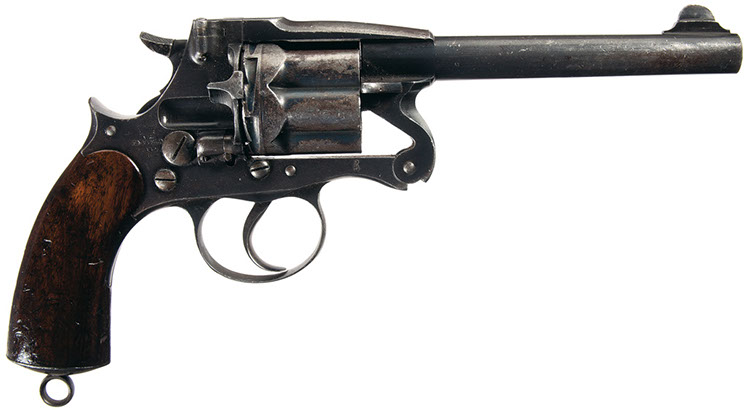
Used: 1882 – 1905
Procurement: 1079 +
Cartridge: .476 Enfield
Capacity: 6 round cylinder
In 1882, NWMP Commissioner A G Irvine requested a new supply of Mk III Beaumont Adams and was surprised to learn from the British War Department that they had been supplanted by a new pattern Enfield revolver. Firing the .476 Enfield, the revolver improved upon the Beaumont Adams in several areas, in particular the top-break ejection principle that saw the spindle plate remain stationary while the barrel and cylinder swung forward. The revolver proved very effective and popular with the force, at least while they were in newer condition. Long term use saw deficiencies with durability creep up. Worn spindles caused issues with extraction and, most noteworthy, further wear of its barrel release bar and the barrel pivoting transverse pin caused barrels themselves to become loose and affect accuracy. Despite this, by 1895 many of the Enfields were still in good repair and the new concern was modern examples of Smith & Wessen and Colt designs rendering them obsolete. While some supplies of replacement Enfields were acquired as late as 1889, the British had long since ceased use of the Enfield for the Webley Mk I. Without a clear replacement in line, it would be 1905 before the force adopted a new standard sidearm to replace the heavy Enfield.
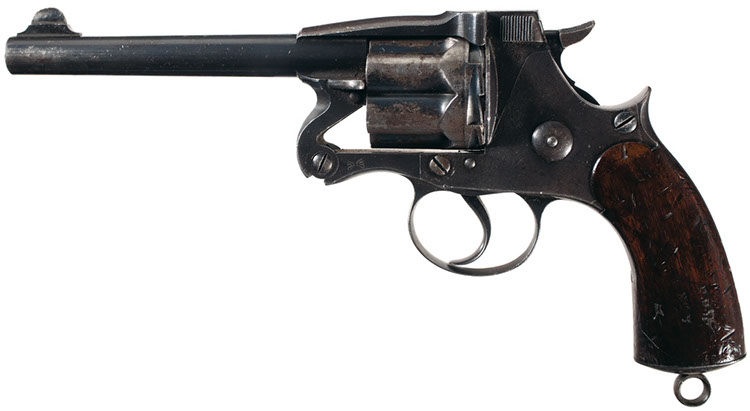
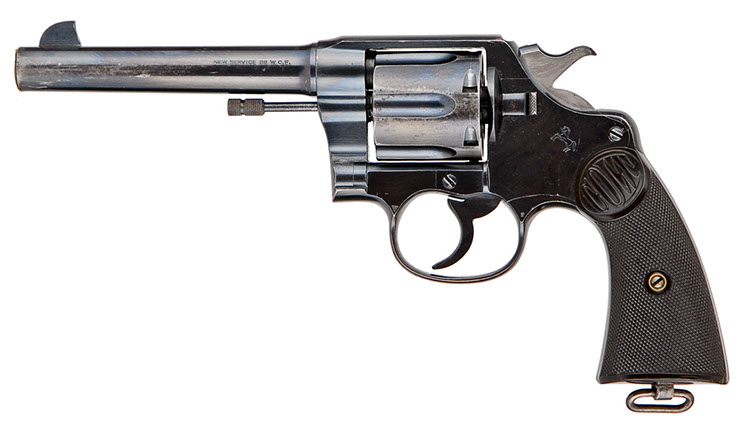
Used: 1905 – 1954
Procurement: 3200 +
Cartridge: .45 Colt & .455 Webley
Capacity: 6 round cylinder
After the Enfield fell out of favour with the force, a transitional period occurred before the widespread adoption of a new service side arm occurred. During this time, the force still issued Enfield revolvers to its members and, with great frequency, patrolmen would carry other revolvers instead. Whether they were privately acquired or issued to the lucky recipient from limited batches purchased by the force for specialized assignments, it was plainly clear the Enfield was inferior to modern options. Many of these were variants of Smith & Wessen .38 pocket revolvers and, to a lesser extent, the British Bulldog.
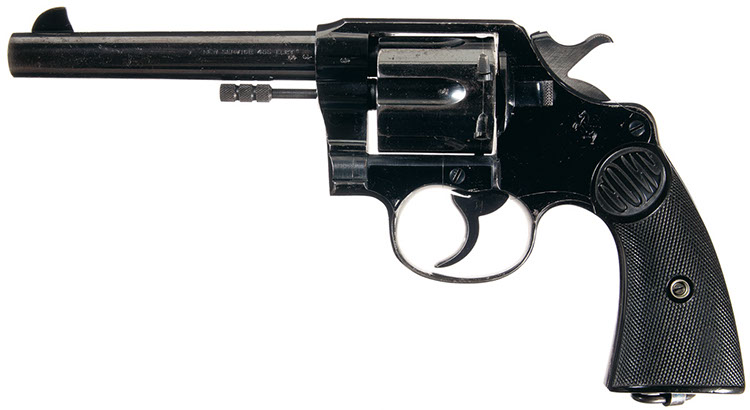
Snider-Enfield Carbine Mk III / Short Rifle
Used: 1873 – 1885
Procurement: 398 (352 Carbine Mk III & 46 Short Rifle)
Cartridge: .577
Capacity: single shot
The true first arm of the NWMP, due to the delayed arrival of Mk I Adams revolvers, was the Snider-Enfield Carbine Mk III. Based on the Pattern 1853 Snider Enfield rifle-musket, 1866 saw the Royal Small Arms Factory develop a breech loading variant that would become the single shot Snider-Enfield rifle. Unlike the Mk I, which were converted copies of the Snider-Enfield musket, the NWMP would receive the Mk III, designated as such as they were newly manufactured examples. And unlike the converted Mk I Adams, they would arrive with the Mounties at Fort Dufferin in good order.
Where they shared an unfortunate trait with Adams is that the Snider-Enfield Mk III carbines were very nearly obsolete by the time of their arrival in the Western territories. Following the American Civil War, there was rapid advancements in firearm technology and the Sniders were simply outclassed by the repeater Winchester, Henry, and Spencer rifles that had begun to show up in large numbers on the prairie. The need for replacement became apparent and forced the NWMP's hand very early, seeing the more modern and ultimately unavailable Martini – Henry drawing consideration, despite already being in limited service. The .44 calibre repeater Henry rifle from down south saw formal recommendation for a brief period of time. This was, of course, until it was decided reliance on a foreign government for ammunition and parts for maintenance was not ideal, so ending plans on that front.

Used: 1878 – 1914
Procurement: 1261
Cartridge: .45/75
Capacity: 8 round tubular magazine
By 1876, it became clear that the rough terrain and conditions were taking their toll on the Sniders and replacement could no longer be delayed. While additional Snider-Enfields were drawn from the militia stores as a stop gap, the issue remained in their obsolescence. Initial testing of the Winchester began in 1878 when the first Model 1876 Carbine was sent to the Mounties, resulting in an immediate purchase of 50 more. So, as best we can tell, the answer to not procuring a rifle which would force the NWMP to rely on a foreign government for firearms, parts, and ammunition was to approve the procurement of exactly that. The first batch of Winchesters were civilian variants and most saw deployment to members who patrolled the US-Canada border. The force would wait another year for an additional shipment of 50, spurred into action for full distribution to the force when the arrival of Sitting Bull in present day Saskatchewan created political tension. It wasn't all good with the 'old pattern' Winchesters though. Despite a report deeming them weak in their construction, full replacement of the Snider was approved in 1881.
1882 saw the arrival of the first new pattern Winchesters, which addressed the flaws as pointed out in Commissioner Irvine's previous report. These would see full distribution to the force by 1885, expedited by the growing threat of rebellion lead by Louis Riel. Each of these new patterns, or “Mounties”, were stamped with the NWMP crescent stamp and are highly collectible today - proving equally popular when newly acquired with praise from Irving himself. However, as was observed during the suppression of the rebellion, the wear and tear of hard use became problematic. Regardless of the frequent servicing required to keep them serviceable, the Winchester would see widespread use until 1905 and then again from 1907 to 1914 in wake of the ill-fated Ross.
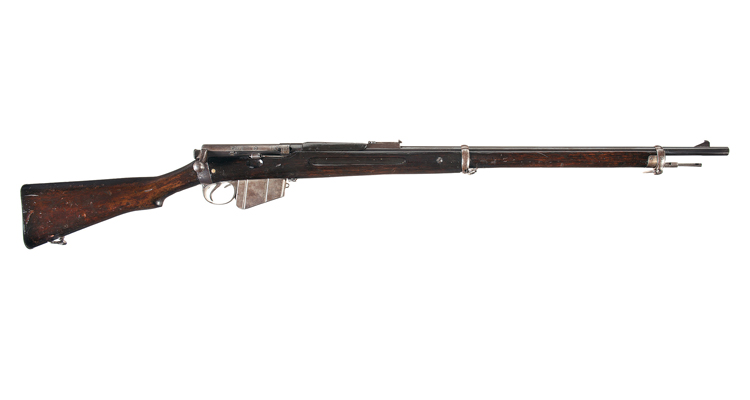
Used: 1895-1914
Procurement: 200
Cartridge: .303 British
Capacity: 6 round magazine
Much like the transitional phase between the Enfield Mk II and Colt New Service, one existed between that of the Winchester and the last individually issued shoulder arm of the mounted police, the Lee Enfield Magazine Carbine. The NWMP (soon the RNWMP) took considerable numbers of various rifles into service, some seeing widespread use within all branches of the force with varying levels of success. Others, not so much.
The first of these was the Lee Metford Magazine Rifle. The force forwarded its first formal proposal to test the Metford, which the British Army adopted as their standard service rifle just months prior in 1888. Replacing the lever action Martini-Henry after years of design and testing, the new Lee Metford was the first bolt action service rifle to see widespread use in the Commonwealth and quickly earned a reputation as a superior firearm. Combining William Ellis Metford's barrel designs and James Paris Lee's brilliant rear-locking bolt system with a detachable eight (later ten) round magazine, this design would the basis of British service rifle design for many years. However, reputation and reality aren't always the same. Its service life was short lived, much of it owed to using black powder versus smokeless powder and soon was replaced by the Lee Enfield Magazine Rifle beginning in 1895; which would be the same year the Mounties began to acquire their carbine variants of the Lee Metford. While they were more than adequate to improve upon and replace the worst worn of the Winchesters, only 200 would ever be acquired as the force would lean to the Lee Enfield Magazine Rifle Mk I just five years later.
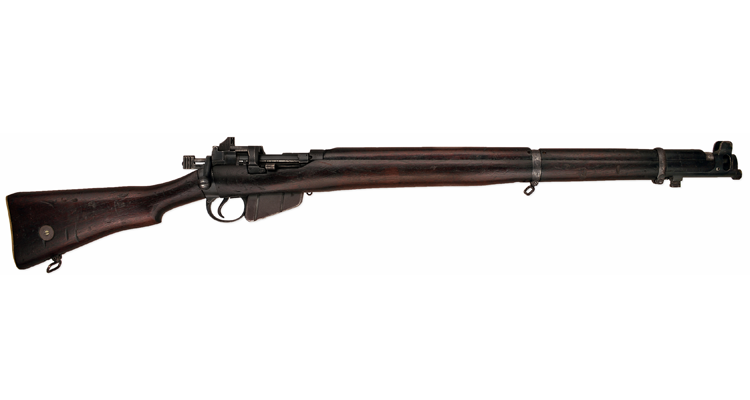
Used: 1900-1920
Procurement: 450
Cartridge: .303 British
Capacity: 8 or 10 round magazine
1895 saw the introduction of the Magazine Lee Enfield, otherwise known as the MLE – ‘Emily’, or ‘Long Lee Enfield’, and with minor upgrades 1899 the Mk I. Just before the turn of the century, limited stocks of Lee-Metfords, and a reluctance toward the Model 1896 Winchester, saw continued small purchases and trials of shoulder arms intended full distribution. Such as when a trek north from Fort Edmonton saw the discovery of a weapons cache pillaged by thieves, this fueled requests to evaluate the Metford’s successor: the Lee Enfield Magazine Rifle Mk I. Surprised, to say the least, was the officer in command in the Yukon when an unexpected shipment of 450 Long Lee Enfields, 100,000 rounds, 200 slings, and 200 of the truly epic sword bayonets arrived in the early months of 1902. This was a most welcomed sight, allowing for widespread distribution over much of the North to replace many of the worn Winchesters. It also welcomed the arrival of smokeless powder.
This loan of arms from militia stores in Victoria and Winnipeg would see only a small portion of the rifles ever being returned. The larger than normal procurement made the MLE the de facto shoulder arm of the NWMP until 1905 (RNWMP by 1904) when the government elected to arm the Mounties with the same arm of the militia on account of its paramilitary ethos. That move would be for the infamous Ross Mk I. Following the dismal failure of the Ross, the Long Lee Enfields would see continued widespread use, with even old Metfords and Winchesters called back to service. It, and the later acquired Lee Enfield Magazine Carbine, would continue to do so until 1920 when the merger with the Dominion Police occurred. They would be the last rifles to see distribution to all of its members.
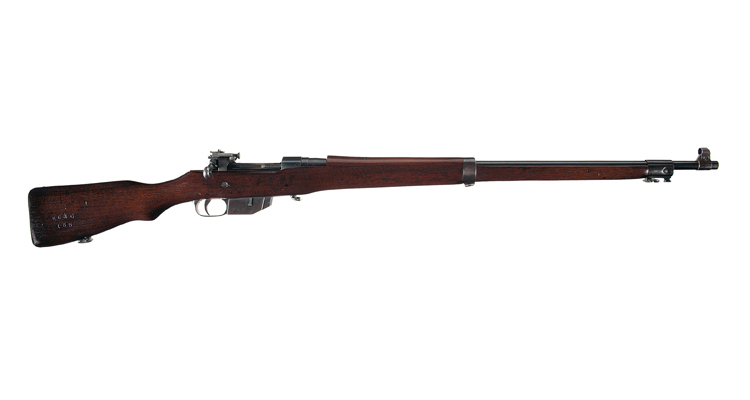
Used: 1905-1907 (Mk I) & 1909-1912 (Mk II)
Procurement: 1000 (both Mk I & Mk II)
Cartridge: .303 British
Capacity: 5 round magazine (both Mk I & Mk II)
While in essence, it could have been an excellent rifle - particularly with the purported advantage of its straight pull bolt action system. In ideal environments, it performed remarkably well and was adopted by the Canadian militia officially in 1902. After recommendation, the Mounties acquired examples of Mk I demonstration models in the early summer of the same year, one of each the rifle and carbine. Despite benefiting from careful manufacturing controls, things started poorly; seeing the carbine crack its receiver after just a few shots. The rifle, however, performed admirably and the replacement carbine did so as well, seeing this prototype further tested in cold weather environments without fault. To this point, the force saw no reason otherwise, placing their order and later issued 1000 of the Mk I carbines. That would be the extent of the Ross` success.
Scheduled for delivery in 1903, delays at the Ross factory in Quebec would stall delivery to 1904. Prior to this, the Mounties sent Inspector E Gilpin Brown to inspect the MP Carbines nearing completion. What he discovered were carbines which differed from the tested prototype. The barrel was an inch longer, the fore-end wood was two inches from the muzzle, not four, and curiously a semi-pistol grip was added. While there, it was decided that the new Mk II`s lever rear sight would be preferable to the Mk I`s H-type, causing further delay until 1905. Once received, poor quality controls during assembly began to rear its ugly head; most notorious being defective bolt-stop springs that would allow bolt-in-sleeves to rattle about and, on occasion, discovered lost on the prairie. Scarier yet was the infrequent bolt assembly blow out, which actually severely injured the eye of one operator in 1907. This prompted the RNWMP to declare them unfit and order all into stores. Promises by Ross for immediate replacement with an improved rifle were assured, but it wouldn’t be until 1909 that the Mk II would arrive in Regina. By then, a cautious RNWMP wanted to ensure their reliability and safety, keeping the newly received 1000 Mk II`s in Regina. But before they were issued to patrol members, all but 34 were lost in a fire in 1912. While the RNWMP would enquire with Ross if could facilitate an order just a year later, no order would ever be placed and so ended the Ross` career with the Mounties.
Lee-Enfield Magazine Carbine
Used: 1914-1920
Procurement: 1000
Cartridge: .303 British
Capacity: 6 round magazine
After the fire in 1912 and assumed dissatisfaction with the tested Mk III Ross, a desperate RNWMP requested an immediate shipment of 1000 carbine versions of the already serving Long Lee Enfields. They were easily acquired. Canada’s militia had received their Mk III Ross Rifles and their stores of `Emily` carbines were declared surplus, being sold to the force at just $1.00 each. Yes, you read that right. This proved to be an excellent situation, allowing the force to remove the previously re-issued Metfords and Winchesters from duty and field a supplementary firearm of excellent quality. These Lee Enfields would prove to be, in conjunction with their rifle variant, the last shoulder arm issued to all its members. In 1920, when the RCMP was granted full national status, the need for mounted patrolmen, and with him his rifle, ceased to exist. The horse had given way to the car. No longer were armed horse thieves or whiskey traders a threat to the peace of the land. As a result, this merger and reorganization of services saw the force recall all of the Lee Enfields back to Regina, ending the era of the frontiersmen police force of old.

Used: 1919-1947
Procurement: 1200
Cartridge: .303 British
Capacity: 10 rounds
While the majority of its career with the Mounties was in stores or used for practice shooting, the Short Magazine Lee Enfield No. 1 Mk III's (SMLE – or 'smelly') iconic status deserves mention. Prior to the amalgamation of the RNWMP and Dominion Police, which effectively ended the days of the rifle wielding Mountie, a large procurement occurred of the SMLE to supplement dwindling stocks of serviceable rifles. In March of 1919, 1200 of these rifles were acquired from militia stores at just $12.00 each – deemed surplus after the conclusion of the Great War where large numbers were acquired. This was the product of the Mk III Ross being replaced by the SMLE due to its inability to cope with the trench mud of Flanders. With the changes of the force, these SMLE's were distributed throughout detachments across Canada for specific duty assignments – such as annual marksmen qualification.